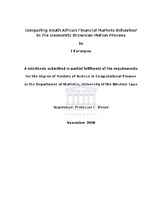| dc.description.abstract | This study examines the behaviour of the South African financial markets with regards to the Geometric Brownian motion process. It uses the daily, weekly, and monthly stock returns time series of some major securities trading in the South African financial market, more specifically the US dollar/Euro, JSE ALSI Total Returns Index, South African All Bond Index, Anglo American Corporation, Standard Bank, Sasol, US dollar Gold Price , Brent spot oil price, and South African white maize near future. The assumptions underlying the Geometric Brownian motion in finance, namely the stationarity, the normality and the independence of stock returns, are tested using both graphical (histograms and normal plots) and statistical test (Kolmogorov-Simirnov test, Box-Ljung statistic and Augmented Dickey-Fuller test) methods to check whether or not the Brownian motion as a model for South African financial markets holds. The Hurst exponent or independence index is also applied to support the results from the previous test. Theoretically, the independent or Geometric Brownian motion time series should be characterised by the Hurst exponent of ½. A value of a Hurst exponent different from that would indicate the presence of long memory or fractional Brownian motion in a time series. The study shows that at least one assumption is violated when the Geometric Brownian motion process is examined assumption by assumption. It also reveals the presence of both long memory and random walk or Geometric Brownian motion in the South African financial markets returns when the Hurst index analysis is used and finds that the Currency market is the most efficient of the South African financial markets. The study concludes that although some assumptions underlying the rocess are violated, the Brownian motion as a model in South African financial markets can not be rejected. It can be accepted in some instances if some parameters such as the Hurst exponent are added. | en_US |

